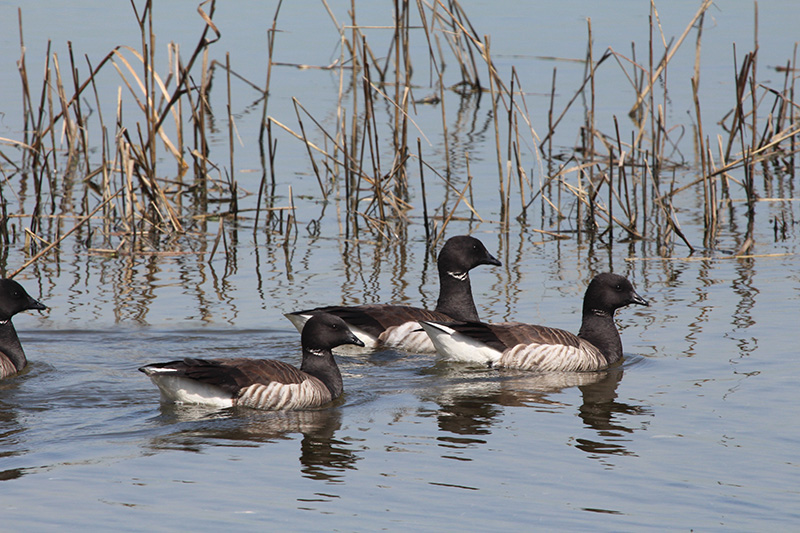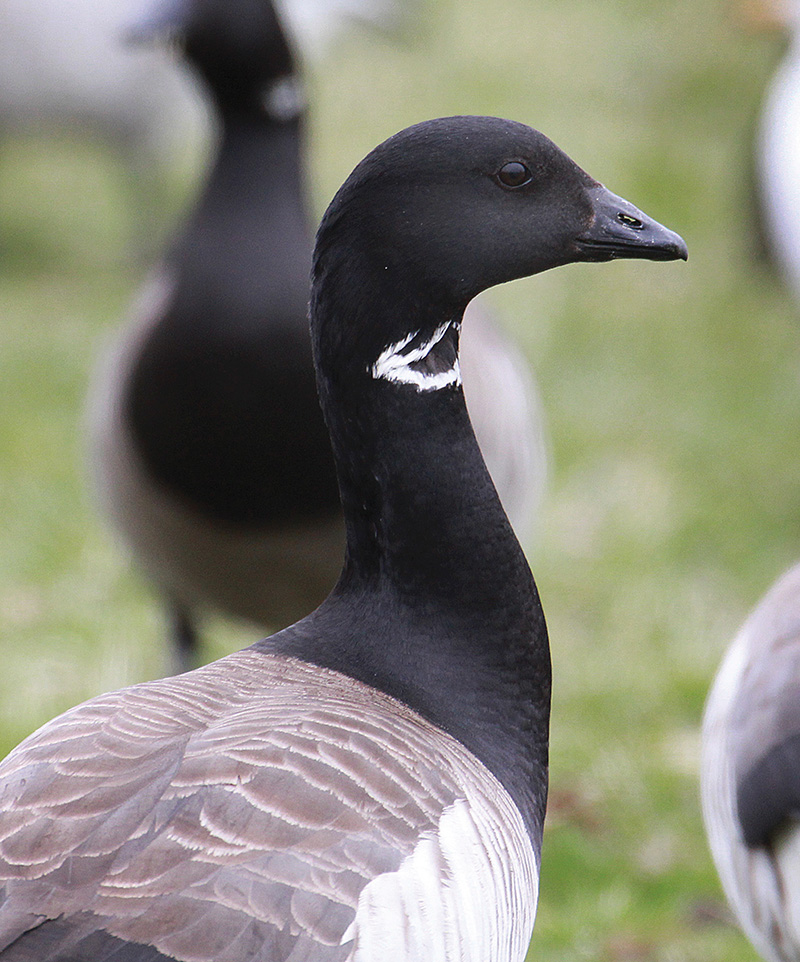
My Appreciation of the Brant
A Demure but Heroic Little Sea Goose
By Paul Spitzer

Image Credit: Courtesy of Chris Bosak—www.birdsofnewengland.com.
I write to share my observations and questions, offering naturalist stories and appreciation. In comparison with big honking Canada geese, Brants are demure little geese, weighing about three pounds. They have a black head and a short black bill, with no white cheek patch. Their black neck is short and stocky, but bears two small opposing patches of white feathers, sometimes painted as a necklace. Loud Canada Geese are often called “Honkers.” In contrast, Brants have a soft gabbling call. Bill Maher, an old South Jersey marsh-dwelling friend of mine, affectionately calls them “Gronkers.” He remarked that “it was truly magic to listen to a thousand on a still winter night” calling across grand expanses of New Jersey coastal salt marsh. Young and soulful, Bill roamed those habitats wearing an Ecology flag as a cape, and happily took the name “Captain Ecology.” I first encountered him and the Brant in the spring of 1971, while documenting the impact of DDT on New Jersey’s much diminished ospreys. I was discovering immense salt marshes and bays for the first time in my life—fabulous places for a young naturalist—and these were graced by the Brant. But why were some lingering well into May?
Because they had to wait for the Arctic to thaw. During breeding season, the Brant is very notably a high latitude circumpolar breeder. Some of their austere breeding sites are hundreds of miles above the Arctic Circle, and 2,500 miles north of Connecticut. Those habitats are challenges for them—and also for our imagination. They face uncertain weather in a short chilly summer, which prevents breeding success in some years. They lay a clutch of only three to five eggs, which is small for a waterfowl. They favor nesting on inaccessible islands, but still face nest predation by arctic foxes, jaegers, and… polar bears! I find Brant life history awe-inspiring and triumphant, almost preposterous. Around the pole, our species Branta bernicla is divided into three similar forms, with three common names: our Atlantic Brant, the darker Pacific Black Brant, and the Eurasian Brent Goose. These names derive from Old Norse “brandgaes,” meaning “burnt goose,” which refers to their black foreparts. The Latin species name bernicla is a whimsy. It means “barnacle,” and refers to the ancient idea that the larval form of a goose whose far-northern nest no one ever saw was the large and prominent Gooseneck Barnacle. This tradition conveniently allowed Catholics to eat Brant on Fridays, because they counted as fish not fowl.
Our Brants’ prime East Coast winter range is the big salt marshes and bays of coastal New York and New Jersey. Thus, they alternate between Canada’s remote high Arctic wilderness, on short-grass coastal tundra, and structurally similar grassy salt marsh habitat adjacent to America’s densely populated eastern corridor. Unlike other opportunistic wild geese, they are mostly limited to coastal saline habitats, and thus were called “The Sea Goose” by writer Nelson Bryant. During the last two years, New Jersey Fish and Wildlife (NJDEP) and New York State Department of Environmental Conservation (NYSDEC) have tagged Brants with little solar-powered backpack transmitters, each weighing an ounce. Thus they can track their epic seasonal migrations. You can watch a great eight-minute video map of the Brants’ travels on YouTube. One southbound autumn Brant, newly arrived in the urban New York Bight, hung around (the Statue of) Liberty Island (LI) for some weeks.

Image Credit: Courtesy of Chris Bosak—www.birdsofnewengland.com.
Brants are often rather tame, coming down in innocence from high arctic places, and were relished as gourmet food by hunters. But that was to change! Formerly, they were dependent on a diet of marine Eelgrass, Zostera marina, along our coasts. Then a 1930s eelgrass blight drastically reduced their numbers. They starved. The great Brigantine National Wildlife Refuge near Atlantic City, New Jersey, was created in 1939, partly to preserve the threatened Brant. Thousands of marsh acres were protected. Since then, the refuge has been greatly expanded and renamed in honor of New Jersey conservationist Edwin Forsythe and has become a mecca for visitors. While once limited by eelgrass, the Brant eventually adapted to feed on marine green algae: Sea Lettuce Ulva, in particular. This coastal water plant spreads rapidly in green sheets, blooming profusely in response to high nutrient regimes created by human activity. The nutrient-rich estuarine waters at the mouth of the Connecticut River offer a prime example.
Now I propose the irony of modern-day ecology, and the Brant’s resulting fate: even a partial Ulva diet makes this hunters’ former delicacy unfit for human consumption. Thus it appears that hunting pressure has declined, and our naturally rather trusting Arctic visitors have become an accessible part of the seasonal living landscape at the mouth of the Connecticut River. They are mostly farther south in deep harsh winter but make a long migratory stay with us from early March into late May. So for us, they are early heralds of the coastal spring. In this new season, fishermen putt around, kayakers explore, and the Brant flocks flush, but they don’t fly far or fast. In recent times, my Connecticut estuary studies of ospreys feeding on abundant planktivorous menhaden fish (also dependent on the local high-nutrient food chain) meant pleasant encounters with Brant and reminded me of my long-ago New Jersey spring discoveries.
On the evening of May 21, 2014, I witnessed a Brant spring migration departure. After an early dinner, I had returned to my cabin overlooking Griswold Point. The sun had set, but it was still bright twilight. Suddenly I heard a gabbling chorus, soft but intense, of Brant flight calls. I scrambled out onto the lawn to see a flock of eighty rising past Griswold Point, flying west along the LI Sound shore, then swinging up the Connecticut River’s mouth, flying fast and gaining elevation. What a gift! I ran to a nearby vantage on the Black Hall River, as quick as my post-prandial stomach permitted, and saw them headed north into the night. They flew roughly in lines; they don’t form the disciplined chevrons of Canada geese. I read that over a two-day period they fly to James Bay, Canada, roughly 800 miles north of Connecticut, which is their famous stopover feeding ground in both spring and autumn. After that, once the Arctic thaws, they fly 1,200+ more miles north to near-mythical nesting places like Baffin, Bathurst, and Ellesmere Islands. What drama and perils these little geese would encounter before returning to our shores: immense flight distances, cold uncertain weather, and formidable Arctic nest predators. For me, these gentle Brants are heroic creatures.
Paul Spitzer, PhD, lived in the Connecticut River valley during his formative years as a naturalist and ecologist. He began his Osprey–DDT research as a student at Wesleyan University. He continued his doctoral research on northeastern osprey population biology at Cornell. He has accomplished conservation biology projects worldwide. He is currently finishing a book about loons.

